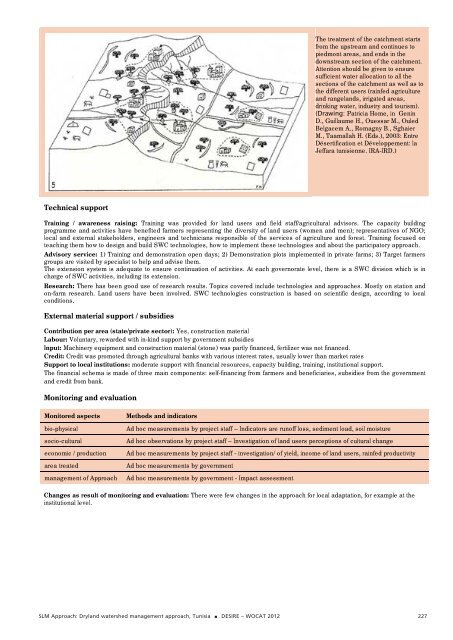Desire for Greener Land
Desire for Greener Land
Desire for Greener Land
You also want an ePaper? Increase the reach of your titles
YUMPU automatically turns print PDFs into web optimized ePapers that Google loves.
Technical support<br />
SLM Approach: Dryland watershed management approach, Tunisia DESIRE – WOCAT 2012<br />
The treatment of the catchment starts<br />
from the upstream and continues to<br />
piedmont areas, and ends in the<br />
downstream section of the catchment.<br />
Attention should be given to ensure<br />
sufficient water allocation to all the<br />
sections of the catchment as well as to<br />
the different users (rainfed agriculture<br />
and rangelands, irrigated areas,<br />
drinking water, industry and tourism).<br />
(Drawing: Patricia Home, in Genin<br />
D., Guillaume H., Ouessar M., Ouled<br />
Belgacem A., Romagny B., Sghaier<br />
M., Taamallah H. (Eds.), 2003: Entre<br />
Désertification et Développement: la<br />
Jeffara tunisienne. IRA-IRD.)<br />
Training / awareness raising: Training was provided <strong>for</strong> land users and field staff/agricultural advisors. The capacity building<br />
programme and activities have benefited farmers representing the diversity of land users (women and men); representatives of NGO;<br />
local and external stakeholders, engineers and technicians responsible of the services of agriculture and <strong>for</strong>est. Training focused on<br />
teaching them how to design and build SWC technologies, how to implement these technologies and about the participatory approach.<br />
Advisory service: 1) Training and demonstration open days; 2) Demonstration plots implemented in private farms; 3) Target farmers<br />
groups are visited by specialist to help and advise them.<br />
The extension system is adequate to ensure continuation of activities. At each governorate level, there is a SWC division which is in<br />
charge of SWC activities, including its extension.<br />
Research: There has been good use of research results. Topics covered include technologies and approaches. Mostly on station and<br />
on-farm research. <strong>Land</strong> users have been involved. SWC technologies construction is based on scientific design, according to local<br />
conditions.<br />
External material support / subsidies<br />
Contribution per area (state/private sector): Yes, construction material<br />
Labour: Voluntary, rewarded with in-kind support by government subsidies<br />
Input: Machinery equipment and construction material (stone) was partly financed, fertilizer was not financed.<br />
Credit: Credit was promoted through agricultural banks with various interest rates, usually lower than market rates<br />
Support to local institutions: moderate support with financial resources, capacity building, training, institutional support.<br />
The financial schema is made of three main components: self-financing from farmers and beneficiaries, subsidies from the government<br />
and credit from bank.<br />
Monitoring and evaluation<br />
Monitored aspects Methods and indicators<br />
bio-physical Ad hoc measurements by project staff – Indicators are runoff loss, sediment load, soil moisture<br />
socio-cultural Ad hoc observations by project staff – Investigation of land users perceptions of cultural change<br />
economic / production Ad hoc measurements by project staff - investigation/ of yield, income of land users, rainfed productivity<br />
area treated Ad hoc measurements by government<br />
management of Approach Ad hoc measurements by government - Impact assessment<br />
Changes as result of monitoring and evaluation: There were few changes in the approach <strong>for</strong> local adaptation, <strong>for</strong> example at the<br />
institutional level.<br />
227









